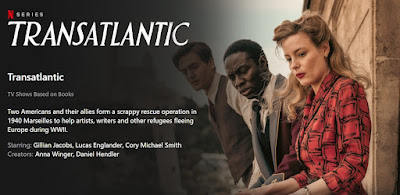His Bravery Unsung: Varian Fry acted - bravely, fiercely, fearlessly - to save Jews - many Jews; many rich and/or famous Jews - during the Holocaust.
But before reading Dara Horn's 2021 collection of essays, People Love Dead Jews: Reports from a Haunted Present, a "startling exploration of how Jewish history is exploited to flatter the living," (see February's Thinking About Anne Frank), Abq Jew had only vaguely heard of him.
Varian Mackey Fry (October 15, 1907 – September 13, 1967) was an American journalist. Fry ran a rescue network in Vichy France that helped approximately 2,000 to 4,000 anti-Nazi and Jewish refugees to escape Nazi Germany and the Holocaust.
He was the first of five Americans to be recognized as "Righteous Among the Nations", an honorific given by the State of Israel to non-Jews who risked their lives to save Jews during the Holocaust.
But that is hardly the whole story of Varian Fry. Dara Horn comes much closer with her essay "On Rescuing Jews and Others," originally published in 2012 as "The Rescuer." Goodreads tells us
In 1941, a young Harvard-educated classicist named Varian Fry arrived in occupied France on a daring mission to rescue more than 2,000 of Europe's leading writers, artists, and intellectuals from the Nazis.
Hounded by the Gestapo, he smuggled Marchel Duchamp, Marc Chagall, Hannah Arendt and dozens of other 20th century cultural luminaries out of France and brought them to America.
So why did even the people Fry saved want to forget him?
In this fascinating psychological profile, acclaimed novelist Dara Horn, chosen by Granta magazine as one of the 25 best young novelists in America, follows the peculiar life and legacy of an American Oskar Schindler.
In the process, she reveals the secrets of a man who risked his life when others were silent — and the unforeseen consequences, personal and cultural, of his bravery.
In his review of People Love Dead Jews, author Tom Reiss writes
Dara Horn has an uncommon mastery of the literary essay, and she applies it here with a relentless, even furious purpose. Horn makes well-worn debates — on Anne Frank and Hannah Arendt, for instance — newly provocative and urgent.
Her best essays are by turns tragic and comic, and her magnificent mini-biography of Varian Fry alone justifies paying the full hardcover price.
But wait - there's much more.
In 2017, Ginia Bellafante wrote in The New York Times
In June of 1935, two years after the German government falsely portrayed the burning of the Reichstag as a Communist plot to overthrow the state and just at the moment that it had banned all but “Aryans’’ from serving in the military and made homosexuality a crime, Varian Fry, a young Manhattan editor who was preparing to take over a magazine called The Living Age, traveled to Berlin.
About one month into his stay, he witnessed a night of gruesome rioting in which Jews were kicked, bloodied and spat on, leaving him to provide one of the earliest accounts of Nazi cruelties in the American news media. Relaying his observations to The Associated Press, Fry remarked that the police “nowhere’’ seemed “to make any effort whatever to save victims from this brutality.’’
Occasionally, he said, “they attempted to clear areas for motor traffic,’’ or to keep people from congregating in front of beloved cafes, but “that was all.’’ The crowds — made up of people young and old, well-bred-looking and common — chanting “‘The best Jew is a dead Jew,’” he continued, conducted themselves as if “in holiday mood.’’
The impression left was so searingthat journalism alone became insufficient.
With that in mind, in August 1940, Fry, a Protestant and 32-year-old, went to Marseilles to begin a covert rescue operation that during his 13-month stay would result in the escape of more than 2,000 people, among them many artists and intellectuals, including Marc Chagall, Hannah Arendt, Max Ernst, Heinrich Mann, Marcel Duchamp, André Breton, Jacques Lipchitz and Alma Mahler, who crossed the Pyrenees carrying Gustav Mahler’s Symphony No. 10, her former husband’s final composition.
And now Netflix tells the story.
Emily Burack writes in Town & Country magazine
Everything We Know About New Netflix Period Drama Transatlantic
The show will tell the story of American journalist Varian Fry who travels to Nazi-occupied France to help save artists and writers.
A new period drama is coming to Netflix this spring, and we can't wait. Transatlantic tells the true story of Varian Fry, a journalist who arrives in France in 1940 and quickly forms the Emergency Rescue Committee—dedicated to helping artists and writers flee the Nazis and immigrate to the United States.
Fry and American heiress Mary Jayne Gold, who helped lead the efforts, found themselves hiding out in a French villa. The two would help some of Europe's most prominent artists and thinkers flee, including Hannah Arendt, Max Ernst, Marcel Duchamp, and Marc Chagall.
Fry would later become the first American to be named "Righteous Among the Nations" by Yad Vashem, Israel's Holocaust museum, for his efforts saving so many Jewish refugees.
Transatlantic is based on The Flight Portfolio, a novel by award-winning author Julie Orringer. Featuring an international cast, the 7-episode Netflix drama filmed on location in Marseille, France.
Premieres April 7, 2023





No comments:
Post a Comment